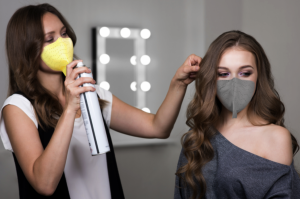Why You Should Wear a Better Mask
- The Omicron variant is by far the most infectious variant to date with experts estimating it is two to three times more contagious as the Delta variant.
Having ~40% of the population infected by a single pathogen in the span of 8 weeks is remarkable and I can’t think of an obvious modern precedent. Flu seasons generally have perhaps 10% infected in the span of 16 weeks. 8/9
— Trevor Bedford (@trvrb) January 20, 2022
One way to protect yourself from the Omicron variants and other potentially harmful variants in the future is to wear a better mask. Not only will you better protect yourself, but you will also help better protect your community, your country, and the world.
Note
These links to resources on masks, videos, and comments by researchers (the “Content”) are for informational purposes only and should not be construed as professional advice. The Content is intended to complement, not substitute, the advice of your doctor. You should seek independent professional advice from a person who is licensed and/or qualified in the applicable area. No action should be taken based upon any information contained in this website. Use of the website is at your own risk. We take no responsibility and assume no liability for any Content made available over this website.
We do not endorse any product listed in this guide — this is for your information only. We have no financial interest in any product listed in this guide and do not earn commissions or any compensation for any links provided in the guide. No vendors have provided us with any free samples.
Version: 1.51, December 24, 2022
Official CDC Guidance on Masks
We recommend you review the CDC page with the agency’s official mask guidance. You can find that page here. We recommend you use an N95 or similar grade mask. These masks are now in plentiful supply and N95s provide much better protection than cloth masks.
The CDC also has this page: “Improve How Your Mask Protects You.”
1. Questions About These FAQs
1.1 What is the goal of these FAQs?
1.2 Who has written these FAQs?
1.3 I found a mistake, or would like something to be added or clarified, can you do that?
1.4 Are these FAQs available in other languages?
1.5 Can I use the information here in other publications etc.?
2. Mask Basics and Official CDC Guidance
2.0 Official CDC Mask Guidance
2.1 Should I wear a mask indoors even if I can distance? YES
2.2 Is it OK to just wear the mask over my mouth and leave my nose out? NO
2.3 Is it ok to remove my mask to talk? NO
3. Why Should I Wear a Better Mask?
3.0 Why you should wear a better mask.
4. What Makes for a Good Mask and a Better Mask?
4.1 Filtration
4.2 Fit
4.3 Breathability
4.4 A note about beards and facial hair
5. What Are Basic Mask Options?
5.1 Introduction
5.2 Cloth masks
5.3 Surgical masks — how to choose
5.4 Surgical mask hacks to get better fit
6. What Are Better and Best Mask Options?
6.1 Introduction, Better Masks = High Filtration + Good Fit + Breathable
6.2 Our Recommended Minimum Better Mask Option — a Cloth Mask on Top of a Surgical Mask
What About Cloth Masks With Filter Inserts?
6.3 The N95, N99 and N100
6.4 Surgical Mask Plus a Mask Fitter or Mask Brace
6.5 Korean Masks (KF94)
6.6 Risky Foreign-Made Masks (the Chinese KN95)
6.7 Elastomeric Masks
6.8 Consumer Grade Powered Air Purifying Respirators
6.9 Fancy N95, N99 and N100 Masks
6.10 Unique Designs Not in Any Other Category
6.11 Avoiding Fakes
6.12 Other Consumer Grade Better Masks Worth Considering
6.13 Other Resources To Find New Types of Better Masks
6.14 Clear Better Mask Options
6.15 Strapless N95 Mask
6.16 Kid’s Masks
6.17 Masks for a Magnetic Resonance Imaging (MRI) exam
7. Getting a Good Fit and Using a Respirator Mask
7.1 How to check to see if your mask is providing a good fit.
8. Reusing a Disposable Respirator Mask.
8.0 Reusing your disposable respirator mask.
9. Special Use Cases
9.1 Teaching
9.2 Masks for retail sales employees and wait staff at restaurants
9.3 Clear Masks — Communicating with deaf persons, use by persons using American Sign Language, or persons who need to convey facial expressions
9.4 Hair Salons
1. Questions About These FAQs
1.1 What is the goal of these FAQs?
The goal of these FAQs is to provide information to the general public in an efficient manner about options to upgrade your mask. We hope this will allow more informed decision making by individuals or organizations. This information on mask options is difficult to find in one place..
1.2 Who wrote these FAQs?
These were written by the volunteer staff of Masks4All. While we’ve studied many materials, none of us are aerosol scientists or doctors. As noted above, use of this information is at your own risk.
1.3 I found a mistake, or would like something to be added or clarified, can you do that?
Yes. Also, if you think you’ve found a mask that appears to offer high levels of protection, but is not listed, please let us know.
Please use this form. Don’t send tweets, emails or DMs as we can’t keep track of questions or suggestions that way.
1.4 Are these FAQs available in other languages?
Yes. At the top left of the page, there is a pull down menu where you can select a different language. Please note that the translation is by machine, not a person. So there are likely to be some errors in the translation.
1.5 Can I use the information here in other publications etc.?
You are welcome to use any of this as you see fit. There is no need to ask permission. We only ask that you give the link masks4all.co/faqs-on-better-masks as the source of the information. Please include the date and version number given at the top.
2. Mask Basics and Official CDC Guidance
2.0 Official CDC Mask Guidance
Note, some of the links below go to another excellent document, FAQs on Protecting Yourself from COVID-19 Aerosol Transmission (at https://tinyurl.com/FAQ-aerosols), which we recommend you review.
We recommend you review the CDC page with the agency’s official mask guidance. You can find that page here.
On Feb. 13, 2021, the CDC announced new guidance titled “Improve the Fit and Filtration of Your Mask to Reduce the Spread of COVID-19.”
The same day, the CDC released “Improve How Your Mask Protects You.”
2.1 Should I wear a mask indoors even if I can distance?
Yes, small droplets and aerosols can travel much further than 6 feet as documented in this paper here. There is no safe distance indoors. These small droplets and aerosols can contain enough viruses to infect you.
As noted in https://tinyurl.com/FAQ-aerosols:
Like other recommendations, these social distance rules will reduce risk, but not eliminate it. The 6 feet rule is based on the idea that large ballistic droplets fall to the ground within 6 feet, although they can travel farther in a cough or sneeze, up to 28 ft (8.5 m). The 6 feet rule also helps with aerosols that do not settle to the ground because they are most concentrated close to the person who released them, like cigarette smoke is most concentrated close to the smoker. Dilution over distance is the main reason why social distance reduces transmission of COVID-19.
Where will the concentrated aerosols from a person go? It is almost impossible to say. Indoor air is a constantly changing, turbulent environment. Even though you can’t feel it, indoor air is constantly moving (typically between 0.05 to 0.1 m/sec, or 0.15 to 0.3 ft/sec) due to heat from your body (adults typically give off as much heat as an old incandescent light bulb, 75 to 100 W), sunlight warming surfaces, people moving and breathing, and mechanical heating and cooling induced airflows. You likely have seen this when looking at visible aerosols floating in a sunbeam, or when extinguishing a candle indoors. The aerosols rarely are all going the same direction.
This constantly changing environment will dilute plumes of aerosols. The dilution will be greater with more time and space. Hence, the farther away you can be from other people indoors, the better.
2.2 Is it OK to just wear the mask over my mouth and leave my nose out?
“No, the mask should cover your nose to block aerosols coming out of it and block any that you might breathe in from the air around you.” (This answer is from https://tinyurl.com/FAQ-aerosols here.)
2.3 Is it ok to remove my mask to talk?
“No, unless you are outdoors at a sufficient distance. Speaking results in about x10 times more respiratory aerosol emission than just breathing, and singing (at high volume) or yelling can be about x50 times more. Ballistic droplets are not exhaled at all when breathing. You should also not allow others to talk to you without a mask from a close distance.”
(This answer is from https://tinyurl.com/FAQ-aerosols here.)
3. Why Should I Wear a Better Mask?
Recent coronavirus mutations appear to be much more transmissible. The CDC says “:The Delta variant is highly contagious, nearly twice as contagious as previous variants.”
One way to protect yourself from this and other potentially harmful mutations is to wear a better mask. Not only will you better protect yourself, you will help better protect your community, your country and the world.
When infected, people can have viral loads in the tens of millions, endangering you and others. A better mask will provide better filtration and fit than a basic cloth mask, better protecting you from inhaling aerosols and droplets containing viruses. Even if you inhale some, you will inhale less of them, perhaps too few to get infected. And if you do get infected, experts believe you have a better chance of having a mild case because your infectious dose would be smaller.
If you are infected, but don’t have symptoms yet, or never get them, then wearing a better mask will better protect others in the community because most of the virus laden particles you emit will be filtered out by your mask.
4. What Makes for a Good Mask and a Better Mask?
4.1 Filtration
Many people understand that better filtration will better protect you from inhaling viruses. Some people think filtration effectiveness is based on how small the holes are in the material, but that’s not how cloth or high tech materials work. This video below by MinutePhysics provides a good explanation of how high tech filtration materials work.
The best cloth masks have difficulty achieving more than 50% filtration efficiency for the smaller droplets and aerosols that can contain viruses. See these reports here, here, and here. Higher tech materials, which are usually made out of a meltblown polypropylene layer, can do a much better job of filtering the smaller particles. You can find these materials in surgical masks and medical respirators such as N95s, which can filter out over 95% of these smaller particles containing viruses.
But the best filtration materials in the world won’t help protect you very well if you don’t also have an excellent fitting mask that is breathable.
4.2 Fit
Far too many people focus on how well the materials in their mask filter the air. That’s a huge mistake. The best filter in the world won’t protect you if a lot of unfiltered air goes around the mask or mask filter. If half the air goes around your 99% filter your effective filtration falls to less than 50%. In many masks with poor fit, half or more of the air you breathe in may not go through your mask’s filtration at all.
This video below is a great illustration of the importance of fit. It primarily illustrates how exhaled air can leak from masks. But if air leaks out, it will leak when you breathe in too.
This picture also illustrates the difference between a loose fit and and a tight fit:
In fact, the materials in a medical grade surgical mask filter air the same or better than the materials in an N95 mask. But an N95 mask will do a better job of protecting you. That’s because, if worn correctly, an N95 mask provides a much tighter fit.
So to get a better mask, it’s just as important, if not more important, to get a tight fit. A leaky mask won’t provide the protection you need.
4.3 Breathability
If it’s too hard to breathe through your mask, more unfiltered air will rush in through the leaks in your mask.
And you’ll probably look for excuses not to wear it. Or you’ll be more likely to wear it incorrectly.
In some cases, carbon dioxide might build up in masks that are hard to breathe. Carbon dioxide is not a silent killer like carbon monoxide, but high levels can lead to impaired consciousness and other health effects. So breathability is important in a better mask.
4.4 Beards and facial hair
If you need to wear an N95 mask for work, you’re not allowed to have a beard or facial hair that would interfere with getting your mask a tight seal. It isn’t possible to get a tight seal against any skin with facial hair.
So if you want to provide the best protection for yourself, you need to remove facial hair so your mask can create a good seal. If for some reason you are not willing or able to remove the facial hair, then you should at least consider wearing the shortest facial hair possible to reduce leakage around your mask.
Here is the official NIOSH guidance regarding facial hair, which is available here. That guidance in part states the following:
Facial hair that lies along the sealing area of the respirator, such as beards, sideburns, moustaches, or even more than one day or 24 hours of growth of stubble, should not be permitted on employees who are required to wear respirators that rely on tight facepiece fit. Facial hair either growing in or protruding into the area of the primary sealing surfaces of the respirator will prevent a good seal. Any degradation to the respirator seal has the potential to decrease respiratory protection to the wearer.
In short, if you want to get the full benefit of a better mask or the highest possible protection from your better mask, you will need to shave any facial hair where your mask needs to contact your face to get a good seal.
That said, most people who want to wear a better mask aren’t necessarily looking for medical-grade protection. In many circumstances, it appears you can still get pretty good protection if you have a short beard (under 1/4″) and wear a hard shell N95 or an elastomeric respirator. By that, we mean it’s possible you could get better protection than someone else wearing a genuine KN95 or KF94. And likely much better than the protection given to clean-shaven people wearing a surgical mask or standard cloth mask.
It could be other types of disposable N95s would give good results, but one study of what appears to be the popular 3M “Aura” mask appears to indicate that this mask isn’t a good choice if you have a beard. There are not a lot of studies on this subject and, clearly, the best protection is available to cleanly shaven people wearing N95 or better masks.
As of December 2021, the most recent study on the topic we are aware of was published in the Journal of Exposure Science & Environmental Epidemiology. Here is one of the charts from the study:

Getting the best fit with a beard.
As noted by the Sikh Doctors Association, “Presence of facial hair deems the individual to have failed [a fit] test, even before starting a fit test, which is not recommended to be carried out in people with unshorn facial hair. This presents a challenge for many health professionals for faith groups such as Sikh, Muslim and Jewish groups. The Singh Thattha technique is an innovative solution developed by Dr Rajinder Singh, and was put to the test in a Pilot study using the much more robust Quantitative fit testing method.”
The “thattha” is an under-mask beard cover. This study, published in the Journal of Hospital Infection, used “a flat elastic rubber sheet (Pilates & Yoga Elastic band™)” with good results. The other study cited above also found substantial improvements in fit from a yoga band.
5. What Are Basic Mask Options?
5.1 Introduction
As explained in https://tinyurl.com/FAQ-aerosols, “masks work to reduce the aerosol spread of COVID-19. The physics are well understood. If a porous obstacle is put in the path of air that contains aerosols, some of the aerosols will end up in the obstacle. See the figure below from Science.”
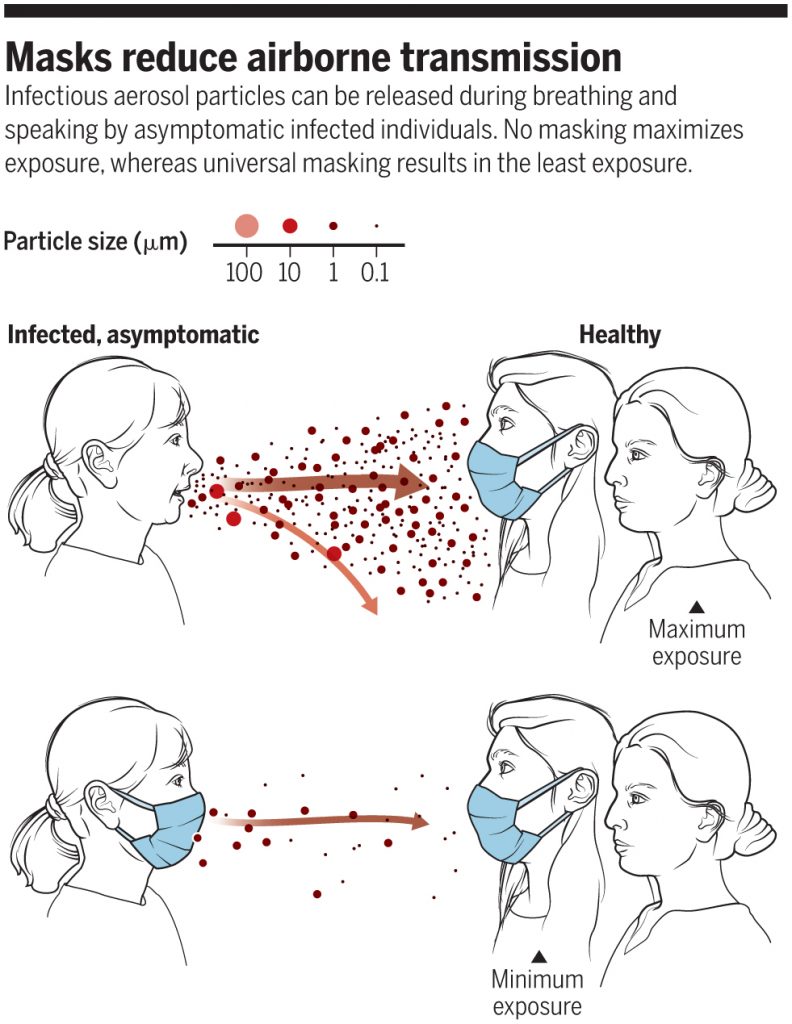
The science is clear, everyone should wear a mask during the pandemic. Any mask will be better than no mask.
But that said, for basic masks, below are the common options, listed from the least protective to more protective. It is believed, but not proved, that some of the most protective of the basic mask options might get up to about 80% effective filtration efficiency. But few basic masks will deliver that level of protection and it’s impossible to know if yours will do it on your face.
Effective filtration efficiency accounts for the quality of the filter and the fit of the mask. Remember, both are equally important. Unfortunately, very little in the way of testing has been done on the fit and filtration possible from basic masks, so these numbers are only estimates.
If you want to have a good possibility of effective filtration assurance in the 80% to 90% range or better, you’ll need to get one of the better mask options described in Section 6.
5.2 Cloth masks
Cloth masks can give decent protection, but the protection you can get varies widely. National standards are expected soon, which will provide consumers with some basic information on filtration efficiency of cloth masks. However these standards will not evaluate fit, which as explained above, is vitally important to getting full protection from your filtering materials.
Until standards are published, you should buy only masks that have been tested for the fabric’s filtration efficiency. You should also be sure to buy one with a nose wire that will help you get a tighter fit around your nose where leaks are common. The nose wire will help provide a better seal around your nose, forcing more air through the cloth filtering material.
Consider carefully the size and shape of your face when choosing a mask. Several cloth mask options come in different sizes.
Experts also recommend buying a mask with a filter pocket so you can add filters to improve your mask’s filtration.
The Wirecutter regularly publishes updated reviews of what they consider the best cloth masks on the market. If you wish to go the cloth route, you should read their review here. The Wirecutter assessment appears to be the best information available to the public at this time and their most recent report included testing for each mask’s filtration capabilities.
The latest Wirecutter ratings included “25 cloth face masks and filter inserts for independent filtration-efficiency and breathability testing at an academic research lab.” But again, keep in mind the study only tested the filtration efficiency of the materials and does NOT account for the fit of the masks.
A paper published by JAMA Internal Medicine in December 2020 found that what appears to be the Easy Mask High Point or Eden, with a nose bridge and filter, achieved a fitted filtration efficiency (FFE) of over 70%. That’s excellent for a cloth mask. The paper did not specify which model of the Easy Mask was tested — this is our best guess by examining the paper and the Easy Mask website descriptions of their mask options. Keep in mind that the research paper only tested one person, so your face, and fit and FFE, may differ substantially. Other cloth masks tested for the paper ranged from 26.5% to about 50% in FFE.
5.3 Surgical masks — how to choose
There are surgical style masks and then there are medical grade surgical masks. One is not necessarily better than the other.
If you buy a surgical style mask from a drug store or hardware chain, you probably are getting a high filtration mask capable of filtering 85% to 90% or more of particles in the sizes that are thought to spread the virus in the air.
Some of the surgical style masks filter just as well as the certified ones. Fix The Mask independently tested a number of the most commonly available surgical style and surgical masks. Their results are listed here. One mask they tested, the Zubrex, did just as well as the masks built to pass one of the ASTM 2100 standards. But Fix The Mask only tested a few samples. Perhaps they got a good lot. There’s no way to say for sure.
If you want more confidence your surgical mask is top quality, then you should look for surgical masks from a manufacturer that is registered with the FDA for selling a Class 2 medical device, which is the category that includes surgical masks. Keep in mind that an FDA listing does not indicate FDA testing or approval of the product. The FDA only reviews the manufacturer’s data. You can access the FDA database here.
For the highest assurance of top quality, you should look for a mask made to the ASTM 2100 Level 2 or Level 3 standard. The filtration quality is identical for those two standards. Both of these masks have at least 98% bacterial filtration efficiency and 98% for sub-micron particulates at 0.1 micron.
The only difference between the two levels is the Level 3 resists blood and other fluids that medical professionals have to worry about. For protecting yourself in daily life, either will work equally well. This graphic shows the difference between ASTM Levels 1, 2 and 3.
One final thing to look for — be sure to check the test results on the manufacturer’s website. The leading independent test lab in the USA is Nelson Labs. If the manufacturer doesn’t show test results, you should probably shop elsewhere.
The filtering materials in an ASTM Level 2 or Level 3 mask are just as good, or better, than the materials in an N95 mask. The N95 protects you better because it provides a tight fit on your face.
While surgical masks provide very high filtration materials, they don’t fit well. Remember, if the mask doesn’t fit tightly, it won’t protect you well.
Even though surgical masks made to the ASTM level 2 or 3 standard can filter over 95% of the particle sizes you wish to remove, the loose fit brings their fitted filtration efficiency (FFE) down to about 38.1% (ear loop version) to 71.5% (with head ties), according to this study. In the CDC experiment cited below, the reduction in exposure with an ear loop design to the tested particles was just 7.5%.
The CDC recommends the use of a mask fitter to greatly improve the protection capabilities of a surgical mask. See Section 6.4 for details.
5.4 Surgical mask hacks to get a better fit
You can improve the fit with some surgical mask hacks.
According to this research paper, “Tying the ear loops and tucking in the corners of the procedure mask to minimize gaps in the sides of the mask increased the mean (SD) FFE to 60.3%” from 38.5%. This study did not specify the quality of the procedure mask used. The same paper found that either use of an ear saver type guard or claw hair clip to pull the earloops tighter behind the head produced similar FFE gains.
But the clear message is with one of these hacks you can improve your overall filtering efficiency by over 20 percentage points, or an improvement of about 50%.
The CDC performed an experiment using headforms and a simulated cough by an unmasked person. The other headform had the surgical mask hack of a “knotted and tucked medical procedure mask.“ It found the receiver with the modified surgical mask, “the receiver’s cumulative exposure was reduced by 64.5%” compared to not wearing a mask. Without the mask hack, a surgical mask only reduced exposure by 7.5%.
The CDC recommends the knotted and tucked hack. Here are three videos explaining how to do this hack:
UNC Health: Pro Tip to Help Your Earloop Mask Fit More Tightly (Video linked to by the CDC)
Dr. Rabeeh Bahrampourian’s video.
The Brush Stop Dental video.
6. What Are Better Mask Options for Hi-Fi Masks?
6.1 Introduction, HiFi Masks = High Filtration + Good Fit + Breathable
We’ll call better masks HiFi masks, meaning they provide higher filtration combined with good fit.
In this section, we’ll cover masks that appear to provide relatively high levels of protection compared to the basic masks in the previous section. Other than the double masking option listed first and the ones listed in Section 6.11, most of the options at least claim to come close, equal or surpass N95 levels of protection. We think, but can’t prove, that these options will provide better protection than any of the options listed above. If a mask has NIOSH certification, then you have the highest assurance of testing and quality. However, there are many better masks that either do not have or will not be able to get NIOSH certification that will provide very good protection.
Unfortunately, current federal regulations provide no pathway for rapidly certifying consumer grade protection or emergency use testing to certify these HiFi masks as meeting N95 level standards. Many of the options described below have not yet passed NIOSH certification. In many cases, the masks will eventually get certification. Obtaining NIOSH approval is a process that often takes many months. We will indicate which ones have at least listed data on their websites indicating high levels of fit and filtration.
6.2 Our Recommended Minimum Better Mask Option — a Cloth Mask on Top of a Surgical Mask
You should always wear a mask. But if you want a mask that offers improved protection, you should avoid wearing either a cloth mask or surgical mask alone. Combining the two is much more effective. If you wear a cloth mask over a surgical mask, in nearly every case you can significantly upgrade your protection compared to cloth or surgical masks alone.
On Feb. 13, 2021 the CDC website recommended placing a “disposable mask underneath a cloth mask” as one way to improve how your mask protects you. In a CDC experiment using headforms and a simulated cough by an unmasked person, “and the receiver was fitted with the double mask, the receiver’s cumulative exposure was reduced by 83.0%” compared to not wearing a mask.
Cloth masks don’t provide good filtration, but medical grade surgical masks have excellent filtration. Some cloth masks provide good fit, but surgical masks have a loose fit. If you can find a tight fitting and breathable cloth mask for your face, then combining it with a surgical mask should give you a substantial boost in protection. Our best guess is that FFE from 70% to 90% might be achievable with such a strategy. A CDC experiment using one unknown cloth mask combined with one unknown surgical mask, “the [double-masked] receiver’s cumulative exposure was reduced by 83.0%.”
Experts recommend this strategy for double masking to increase your overall fitted filtration efficiency (FFE), a way of measuring how well the mask performs for fit and filtration.
We believe you are likely to get the best result by wearing a breathable and tight fitting cloth mask on top of a surgical mask. That’s because some cloth masks provide a good fit while a surgical mask provides high filtration. The combination almost certainly produces better results than either type of mask can produce on its own.
The Wirecutter review indicated that the Kitsbow solid, Cottonique Elite and Baggu masks were the most breathable among the favorite masks they tested. The Fix The Mask testing indicated the Outdoor Research mask was the most breathable. If you want to double mask, we suggest picking from one of these four masks to find the best fit for your face, then wearing a quality surgical mask underneath it to provide effective filtration.
If you have a cloth mask that already fits well on your face, and has a nose wire, there is no need to buy a new one. Simply try wearing your cloth mask over a surgical mask. If you find you can breathe easily, then chances are this option is fine. If it is too hard to breathe, try one of the cloth masks rated highly for breathability and see if it gives you a good fit.
If you use a cloth mask alone, the CDC recommends two or more layers of washable, breathable fabric.“ However, we don’t recommend double masking with two cloth masks with two or more layers of fabric. This might make it difficult to breathe and may not produce high FFE. Many cloth masks have filtration efficiencies well under 50%. In some cases, double masking two cloth masks could produce a drop in FFE. That’s because it might be so hard to breathe through the materials that more unfiltered air instead comes from leaks in the mask.
What About Cloth Masks With Filter Inserts?
In concept, a cloth mask plus a filter insert will better protect you than just a cloth mask. It likely won’t hurt and for some masks it may increase the overall filtration efficiency by 10 percentage points or more. However, we don’t think it will protect better than a surgical mask under a cloth mask. A surgical mask is larger than any of the filters that will fit inside your cloth mask pocket. So a surgical mask will provide more filter area to filter air coming through the mask into your lungs. ASTM rated surgical masks are also made out of high quality filtration materials.
One concern is the filter inserts are smaller than the cloth mask. The filter will provide more resistance to the air coming through the mask, so it may in some cases result in more unfiltered air coming in from leaks in the mask. If it does that, the improvements from the higher filtration may well be offset by an increase in unfiltered air.
Another concern is that many of the filters that come with masks are made out of low quality filtration materials. They might just add more air resistance without adding much, if any, filtration efficiency. Some masks that are available with filters come in custom shapes so that it is often hard to put in an aftermarket filter that fits well.
If you do go this route, we recommend you choose a mask found by the Wirecutter reviews to come with a relatively effective but breathable filter. Another option to consider is a filter made from the same material as a surgical mask, such as this or this, if your mask has a filter pocket but no custom shaped filter.
6.3 The N95, N99 and N100
The N95 mask is considered the gold standard in personal protection. That’s the mask doctors and nurses wear when treating COVID patients. Only masks that are certified by NIOSH may carry the N95 label. You may also see an N99 or N100 rated mask. That’s similar to an N95, but with higher filtration efficiency and better fit.
If you can find an N95, can afford it, and wear it properly, you will get great protection. Before you buy a box of 50 or more of a particular brand, you may want to try to buy one or get a sample if possible. Many brands are made in just one size, and that size or shape may not work all that well for you or your face.
But many people don’t know how to wear an N95 properly. Medical professionals must pass a fit test with an N95 respirator in order to ensure they are wearing it properly. We’ve seen plenty of politicians on TV who have no clue how to wear an N95.
Be sure to read the information in section 7.1 on getting a good fit.
According to the website Patient Knowhow, a study of “60 participants by the Australian Society of Anesthesiologists, 98% of elastomerics passed fit testing versus 57% of disposables (Table 1). This suggests that (in general) it is easier for end-users to form a face seal with an elastomeric than a disposable. Whereas in a study published by the American Medical Association, the differences were less pronounced, 92.2% of participants passed fit testing with elastomerics compared to 88.5% using disposable N95.” Keep in mind these studies were conducted on healthcare professionals, so your likelihood of getting a proper fit is probably worse.
Also, some N95 masks come with valves that won’t filter some of the air you exhale. If you wear an N95 with a valve, you should wear a breathable cloth or surgical mask on top to filter air coming through the valve. Another option is to block the valve with tape.
Also, don’t get fooled into thinking any mask with “95” in the name provides the same protection as a NIOSH N95. Many uncertified and fake foreign masks put “95” in the name. This provides no assurance of high filtration quality.
6.4 Surgical Mask Plus a Mask Fitter or Mask Brace
Another great option is to combine a surgical mask with a mask brace or mask fitter, two phrases for the same thing.
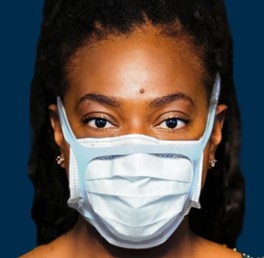
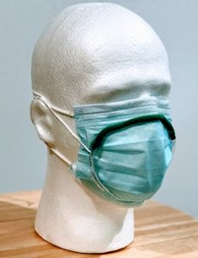
CDC recommends the use of a mask fitter in its official Feb. 13, 2021 guidance titled “Improve How Your Mask Protects You.” A recent CDC research paper said that “results [from another study] indicated that when fitters are secured over a medical procedure mask, they can potentially increase the wearer’s protection by ≥90% for aerosols in the size range considered to be the most important for transmitting SARS-CoV-2 (generally <10 μm).“
As discussed above in Section 5.3, an ASTM rated Level 2 or Level 3 surgical mask filters just as well as the materials used in the N95 masks. The problem with surgical masks is they don’t provide a tight fit. That means unfiltered air can enter from around the top, bottom, and sides of your mask.
A mask fitter fixes the surgical mask to get a tight fit such that you can effectively get N95 level protection if you use a well constructed mask brace and a high quality surgical mask.
The CDC confirms that mask fitters work. John Brooks, MD, chief medical officer of the CDC’s COVID-19 Response recently said, that a combination of a medical grade surgical mask and fitter, “is getting into that range of filtration efficiency afforded by N95 respirators.” You can view the portion of his Jan. 29 briefing on mask fitters here.
An article by the Business Insider summarizes the evidence for this combination.
There are three mask braces/fitters on the market we are currently aware of:
- The Fix The Mask brace.
- The Badger Seal.
- Various 3D printer mask fitters (search online).
Below is a good three-minute video by Fix The Mask that explains the importance of mask fit and why a mask brace works.
Please see Section 5.3 for information on how to find a good quality surgical mask to pair with your mask fitter/brace.
6.5 Korean Masks (KF94)
Korean KF94 masks are similar in performance to the USA certified N95. This post by Smart Air summarizes the differences, which are minor.
Our advice is that if you buy KF94 masks, look for ones made in Korea. The Korean certification process is well regarded by those in the industry and your chances of getting a quality KF94 appears to be much higher than for the Chinese KN95s. Some KF94s are made in China. It’s not that Chinese-made KF94s are necessarily worse, it’s just that many fake masks appear to be manufactured in China.
Aaron Collins has made a series of useful videos testing KF94 and other masks. Generally speaking, he has found nearly all KF94 masks from Korea to be of high quality. Here is a spreadsheet by Collins, which summarizes his results.
Be sure to read the information in Section 6.3 on how to get a proper seal.
6.6 Risky Foreign-Made Masks (the Chinese KN95)
The specifications for Chinese KN95 masks are similar to those for the USA certified N95. The problem with buying a KN95 is that it is difficult to know if you have a good one that meets the standard or not. In the United States we have NIOSH to check if masks meet the standard or not. If a manufacturer starts making shoddy masks, NIOSH will yank approval. Here’s an example. In China, there is no regulator to check if the masks meet the claimed standard.
As a result many KN95s don’t meet the standard’s specifications. Smart Air tested the filtration efficiencies of 31 masks from 21 manufacturers. Eighteen of them flunked, about 42%. Worse is that many of the ones that flunked missed the standard by a huge margin. Six of them failed to filter at even half the standard.
Some don’t even try to meet the standards. They are just fakes. Lloyd Armbrust, the CEO of mask manufacturer Armbrust American bought every mask he could find on Amazon. Here are two tips to spot fakes:
Here’s an almost foolproof way to see if your #KN95 is fake.
1. Real KN95s have “GB2626” imprinted ON the mask
2. Use of the old FDA’s logo on the bag or box
100% of the masks I’ve tested with either have been fake (this one bought from the airport tested at 45% filtration) https://t.co/gAaExyegFY pic.twitter.com/bwwjM3oin8
— Lloyd Armbrust (@larmbrust) August 23, 2021
The quality control for KN95s is so lacking that in October 2020 the FDA warned that the agency “is concerned that certain filtering facepiece respirators (respirators) from China may not provide consistent and adequate respiratory protection.” As such it would no longer update its emergency use list, which had specified KN95s.
On February 2, 2021 the National Personal Protective Technology Laboratory (NPPTL) published International Assessments for many foreign made masks, including KN95s. Some minimum KN95s filtration results were under 26%! But others had very high filtration.
Of the 455 legitimate masks tested by NPPTL (excluding the 3M branded ones — all of them met the standard), the average minimum filtration was 80.3%, well under the 95% standard. The report also found 128 of the lots tested had at least one mask with less than 80% filtration. Of the 49 counterfeits, the average minimum filtration was just 45.9%, less than half the promised filtration.
From the introduction to the assessment:
[T]en respirators were submitted for evaluation. The samples were tested using a modified version of NIOSH Standard Test Procedure… Only particulate filter efficiency was assessed. The results of these tests are for the sample tested and may or may not be representative of a larger lot or population of similar respirators. The results of any filter penetration test can only be used to provide a check of the product’s filter efficiency. No conclusions can be made regarding equivalency to N95 products that are NIOSH approved. (Emphasis added.)
No certificates of approval were provided with the samples received. Therefore, the authenticity of the claims, that the product meets a particular international standard, cannot be validated….
Most of these products have an ear loop design. NIOSH-approved N95s typically have head bands. Furthermore, limited assessment of ear loop designs, indicate difficulty achieving a proper fit. While filter efficiency shows how well the filter media performs, users must ensure a proper fit is achieved.
Remember what we warned you about earlier — the fit of your mask is just as important as filtration. If you want top protection, you should only buy versions with a headband design, not earloops.
If you do buy a KN95, be sure it has filtration results of over 95% from this report or updates to it. Even then, that is NO guarantee that the one you buy will perform the same.
We can’t recommend you buy a KN95, but if you do, you should buy one at a major US retailer that was tested and exceeded filtration standards in the report cited above. Keep in mind what NPPTL said in releasing the report: “The results of these tests are for the sample tested and may or may not be representative of a larger lot or population of similar respirators. The results of any filter penetration test can only be used to provide a check of the product’s filter efficiency. No conclusions can be made regarding equivalency to N95 products that are NIOSH approved.”
If you buy a KN95 at a national retail chain, the hope is that the chain’s buyers will insist on independent tests and get a mask that meets or comes close to the specifications. That’s only a hope. If you buy at Amazon or eBay, you are probably even less likely to have confidence in the quality you are getting. We don’t recommend trusting high ratings left on those websites. People who leave ratings for masks don’t have the expensive equipment needed to test masks for filtration.
The fact any KN95 was on the last FDA list (scroll down to Appendix A) from October 15, 2020 is nice, but the February NPPTL report is more useful.
A possibly reliable KN95 option
One option for a KN95 that may give you a good chance of getting a good one is the Powecom KN95s at Bona Fide Masks., That US online retailer publishes a statement saying they buy only directly from the manufacturer and that they are the “Premier Authorized Distributor in the U.S.” The headband style is likely to provide better fit, and thus better protection. We also consider Project N95 a trusted supplier of the Powecom and N95 masks.
Powecom’s website provides information on how you can verify you have one of their genuine masks. The Powecom masks did not fail in the CDC testing of foreign masks. Aaron Collins has tested three Powecoms and all provided claimed filtration or better. Keep in mind the CDC tests “are for the sample tested and may or may not be representative of a larger lot,” including the one you may buy. But obviously it is a good sign that the tested filtration levels were high.
6.7 Elastomeric Masks
The CDC explains that elastomeric masks are “where the facepieces are made of synthetic or natural rubber material, can be repeatedly used, cleaned, disinfected, stored, and re-used.”
Consumer Elastomeric
The Flo Pro is worth considering, especially if you are looking for a very breathable mask. It is the only consumer grade elastomeric mask we know of available in the USA.
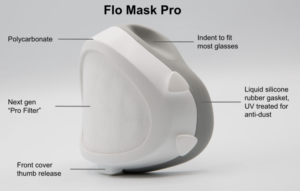
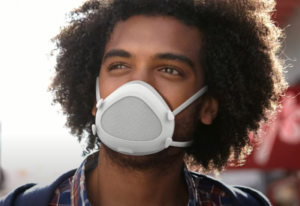
Medical and Construction Market Elastomerics
Many of the construction market elastomeric masks resemble a gas mask, but these or the medical market masks are typically more comfortable and cheaper than an N95 if you use masks every day for work.
The initial cost for elastomerics aimed at the medical market typically ranges between $40 and $80. Compared to N95s disposable masks, which are supposed to be thrown away after a single use, elastomeric respirators use filters that need to be replaced only once a year unless they become damaged, soiled, or clogged. They cost much less per hour of use and an American College of Surgeons study revealed costs could be cut by about 90% by switching from N95s to elastomeric respirators. The same study also reported that “After a month of use, no one wearing an elastomeric mask chose to return to an N95 mask.”
If you work as a first responder or in the medical profession, elastomerics are a great option. If you must fly on long flights, an elastomeric is also a great option that should provide excellent protection and comfort and not look too strange.
Medical and Consumer Market Elastomeric Options With Two-Way Filtration
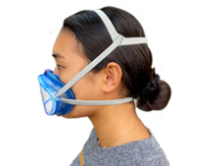
The Envo Mask has NIOSH N95 certification and provided us with a NIOSH label via email indicating N95 approval with use of the mask valve plug now shipped with the mask. For reasons we do not yet understand, this approval with use of the plug does not appear on the CDC/NIOSH certification list. The Envo Mask is one of the best, if not the best, elastomeric masks on the market for being heard while talking. The company provided us with NIOSH approval numbers TC-84A‐8448 and TC-84A‐9228 for the various configurations, including the valve plug.
The Dentec Safety Comfort-Air®NxMD also has NIOSH approval and comes in two sizes and two colors, white and black. The white one can be easily labeled with a marker so people can keep track of their masks and provide caring and cheerful messages to patients. It appears more compact than many other elastomerics on the market and offers both NIOSH approved N95 and P100 filter options.
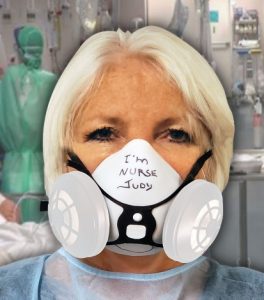

We list the MSA Advantage 290 in this group because it claims it was the first NIOSH approved respirator without an exhalation valve. With its two-way filtration, it provides protection for the user and others. It comes in three sizes and has a P100 option. Most people will find it hard to communicate while wearing these types of masks. As of February 17, 2021 these appear to have up to an 8-week lead time for orders.
The following elastomeric masks with two-way filtering provide test results indicating they would pass NIOSH filtration and fit standards. The company says it is in the process of obtaining NIOSH certification:
3M’s 6000 series comes in three sizes and offers two-way filtration when fitted with the 3M Exhalation Valve Filter 604. Their product information page is full of useful information on how to protect healthcare workers.
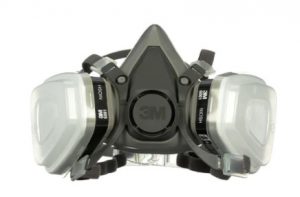
The OSR-Model 1 does not yet have NIOSH approval, but its website provides strong test results.
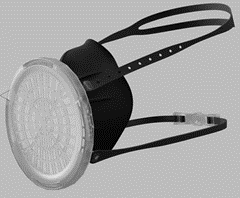
Construction/Industrial Market Elastomerics
There are many other elastomerics, too numerous to cite here, that are aimed at the construction and industrial markets. These are easily found at Grainger, Home Depot, Lowes, Amazon, etc. Search for “Half Facepiece Reusable Respirator” or a similar term and you will find many options. Many of these start at around $20 (without the necessary filters), but have even more of a gas mask appearance than the ones aimed at the medical market.
The Wirecutter, a product review site owned by The New York Times, recommends the 3M 6502QL/49489 Rugged Comfort Quick Latch Half Facepiece Reusable Respirator, which it says “is comfortable to wear and widely available in multiple sizes.” It also recommends the 3M 3M 2097 P100 filters, which we agree are a good choice for excellent protection.
It can be difficult to talk through these types of elastomerics compared to the medical market ones, but you will get very strong protection if you wear it correctly. P100 rated filters for these masks, which filter nearly 100% of small particles, are inexpensive and will last for a long time. Leading manufacturers of these masks include MSA, 3M, and Honeywell. If you get one of these construction/industrial masks, you only need to buy and install a particulate filter. There is no need for a filter that is rated for organic vapors to protect yourself from the virus.
These elastomerics were not designed with a pandemic in mind. That’s why NIOSH certified elastomerics typically have an exhalation valve. The problem with a valve is such a mask provides less protection for people around you and people may be upset at you if you wear a mask with a valve.
The CDC recommends the following:
Preliminary data suggests that the outward leakage from exhalation valves is less than or comparable to that of many devices being used for source control (e.g., cloth masks, bandanas, surgical masks). However, until more research is available, masks with exhalation valves or vents should NOT be worn to help prevent the person wearing the mask from spreading COVID-19 to others (source control). Here are some tips when it comes to exhalation valves:
Wear a respirator without an exhalation valve when both source control and respiratory protection are required.
If only a respirator with an exhalation valve is available and source control is needed, cover the exhalation valve with a surgical mask or a cloth mask that does not interfere with the respirator fit.
You can place a surgical mask over the exhalation valve to provide some source control from your mask as illustrated below.
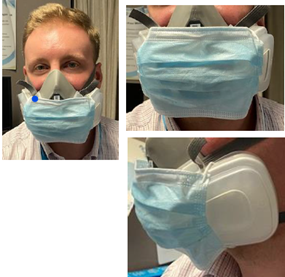
Photo from instructions for a 3M mask showing how to use a surgical mask for source control on a half facepiece reusable respirator with an exhalation valve.
The design of your elastomeric may or may not allow for covering the valve with a surgical or cloth mask or it may make it too hard to breathe. If you can’t place a surgical mask over the valve, another option is to plug or cover the valve, which is likely fine for short term use such as shopping. But we can’t recommend you wear an elastomeric with a sealed valve for long periods of time because of the possibility of carbon dioxide (CO2) build up inside the mask. Carbon dioxide is not a silent killer like carbon monoxide. Still, high levels of carbon dioxide can have health effects.
There are increasing numbers of elastomeric masks available that provide two-way filtering.
If you decide to use an elastomeric, be sure to carefully follow the manufacturer’s instructions for putting it on and taking it off. The video below gives general instructions on wearing a half mask respirator and is worth watching.
6.8 Powered Air Purifying Respirators
A powered air purifying respirator (PAPR) usually uses a battery operated fan to pull in air through a filter and blow filtered air into your mask. The advantage of a PAPR is that it is exceptionally easy to breathe compared to other HiFi masks. The air inside your mask is also at a much lower temperature.
We know of only one consumer grade PAPR on the market, the JustAir. The mask appears popular with many dentists, who have substantial potential exposure to possibly infected patients. If you can afford its high initial cost, $249, this is probably the easiest breathing better mask option on the market. The mask provides two way filtration. Unfortunately, this mask is not currently available for sale.
The mask probably offers significant protection for men with beards because of the filtered air pumped in the mask. However, the company warns that it “works best on a clean, shaven face. A beard will prevent the JustAir mask from properly fitting, which may prevent your exhaled air from being filtered, thus reducing the goal of protecting others.”
The company says it is working toward “a NIOSH-certified version of the JustAir Advanced Face Mask system.”
Most PAPRs are industrial looking and impractical for everyday use. The exception is the CleanSpace Halo or CLEANSPACE2 These start at $1122.
6.9 Fancy N95, N99 and N100 Masks
There are likely many other N95 or better masks with special features or designs on the market, but here are several we are aware of. These masks have special features aimed at providing more comfort.
NIOSH approved
- The Soft Seal N95. This disposable mask respirator has a soft silicone seal that likely makes it more comfortable than a standard disposable N95. It is one of the few masks that come in multiple sizes, including small The comfort comes at a higher price, $6.99 each or $$37 for a box of 10. There is a version without a valve so you can wear it and protect others in the event you are infected. Valved versions are available at Lowe’s and Tractor Supply.
- Moldex 4200 N95 AirWave. Moldex makes a variety of N95 masks with extra features beyond the standard disposable respirator. This model appears to have some folds in the filtering material, which, if true, would provide more filtering area. The manufacturer claims this model’s “design means more air flows in and out of the mask” to allow for “easier breathing.” The company also claims the “FlexFit design moves with your mouth for comfort all day long.” Standard N95s often have difficulty maintaining a seal when the wearer speaks. The masks sell for $30 for a package of 10 at Global Industrial Supply.
- GVS N31000 Fully Adjustable N99 Respirator. At least two experienced mask users have told us this is one of the most comfortable N99 or N95 masks on the market. Both have told us the fit, at least on their face, feels excellent. The manufacturer also sells these on Amazon here.
Seeking NIOSH approval
- The Airgami. If you want what the manufacturer claims is N95 protection but want something stylish and unique, the Airgami might be just what you’re looking for. The company website shows test results, and the company claims, with Nelson Lab test results to document it, exceptional filtration and breathability. Inhalation and exhalation breathing resistance values for three samples tested came in at less than 4.3 mm H20, If you have found it hard to breathe through other N95s, the Airgami may be worth trying just for that feature alone.
The fit factor test results (tests were by the company, not an outside lab) were also very high. Some standard N95s have difficulty achieving high fit results for reading a script, but the claimed scores for that were also high. If you must talk in an N95 for work, the Airgami may also be a good mask to consider. We recommend you purchase the headband version, not the earloop version. You may need to type a note specifying this as you checkout. We recommend you watch their video to fit it properly.
It comes in a range of colors and claims to provide N95 level fit and filtration and the company says it is working toward NIOSH approval. The mask comes in four sizes, also unusual for a respirator. Prices range from about $24 for the white version to $30 each for any of the wide variety of colors and patterns. The company says the mask “can last more than a month under typical urban-wear conditions.” The website provides cleaning and disinfection instructions. The company says it is in the process of seeking NIOSH approval. Below are two of the many colors available.
Here is a one minute video of the inventor wearing it. From the video you can get a better idea of how it fits to your face and how easy it is to talk.
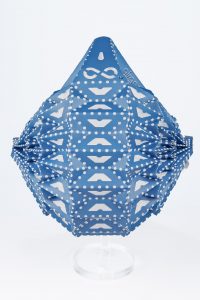

6.10 Unique Designs Not in Any Other Category
Other promising designs will be listed here. Only those showing data documenting high filtration claims will be listed and none are NIOSH approved.
- Breathe99 B2 Mask. This mask is similar to an elastomeric. Instead of being held on by straps attached to the mask, there is a knit overlay (available in a variety of colors) used to hold the mask on to your face. It costs $60, but discounts are available if you order multiple masks. At this time it only comes in one size, but other sizes appear to be coming in the future.
6.11 Avoiding Fakes
There are a disturbing number of counterfeit masks on the market that claim NIOSH certification as N95, N99, or other types of respirators. A genuine mask will list the NIOSH approval number, which starts with a “TC.” There will also be a filter class code of N, P, or R) and a number — 95, 99, or 100, depending on the level of filtration. The letter N indicates it is not resistant to oils, while P or R indicates partial or strong resistance. For protection against viruses, N is all you need.
Keep in mind that for websites like Amazon or eBay, there is not necessarily any vetting of vendors that claim to be selling NIOSH-approved products. We recommend checking a mask manufacturer’s website to see if it lists authorized stores or online sellers where their masks can be bought. If you buy from one of the stores listed by the manufacturer, that will provide substantial protection against getting a fake mask.
One sure sign of a counterfeit N95 mask is a claim or marking that it is “FDA Approved.” The FDA does not approve medical respirators. Only the National Institute for Occupational Safety and Health (NIOSH) certifies N95s.
Another sure sign of a fake is a mask with earloops. We know of no N95 certified respirators that only use a set of earloops.
NIOSH has a not very user friendly website where you can check if the mask is on its certified list. We made a short video to show you an easy way to search for a particular disposable respirator (e.g., N95, N99, etc.). If you know the NIOSH approval number, go to this part of the NIOSH website and you can check on the approval.
From NIOSH:
Counterfeit respirators are products that are falsely marketed and sold as being NIOSH-approved and may not be capable of providing appropriate respiratory protection to workers.
When NIOSH becomes aware of counterfeit respirators or those misrepresenting NIOSH approval on the market, we will post them here to alert users, purchasers, and manufacturers.
How to identify a NIOSH-approved respirator:
NIOSH-approved respirators have an approval label on or within the packaging of the respirator (i.e. on the box itself and/or within the users’ instructions). Additionally, an abbreviated approval is on the FFR itself. You can verify the approval number on the NIOSH Certified Equipment List (CEL) or the NIOSH Trusted-Source page to determine if the respirator has been approved by NIOSH. NIOSH-approved FFRs will always have one the following designations: N95, N99, N100, R95, R99, R100, P95, P99, P100.
Signs that a respirator may be counterfeit:
No markings at all on the filtering facepiece respirator
No approval (TC) number on filtering facepiece respirator or headband
No NIOSH markings
NIOSH spelled incorrectly
Presence of decorative fabric or other decorative add-ons (e.g., sequins)
Claims for the of approval for children (NIOSH does not approve any type of respiratory protection for children)
Filtering facepiece respirator has ear loops instead of headbands
While NIOSH does have a page with known fakes, keep in mind counterfeits come out faster than the government can list them. It’s best to rely on the list of approved respirators.
6.12 Other Consumer Grade Better Masks Worth Considering
None of these designs are NIOSH approved and appear unlikely to seek NIOSH approval. That said, these may provide good levels of filtration and fit comparable with double masking with a tight-fitting cloth mask over a good quality surgical mask. Unfortunately, it is hard to say for sure as the manufacturers don’t provide data for both filtration and fit.
- The AirPop Essential. The company provides evidence of high filtration levels (over 95%) and claims 40-hour protection. The mask looks like it would provide many faces with a good fit but as of version 1.0 of this FAQ the company website did not appear to list any data on fit. The masks come in a minimum order of 20 masks for $120.
- KandyMask 6.0 (without valves) The company provides evidence of high filtration levels (over 95%) and claims breathability of no worse than 7.8 mm H2O/cm2 (its test report showed all of the five samples tested at under 6.3 with most at 5.0). The masks come in four sizes and have a nose wire. The cost is $29 per mask and the company also sells a UV-C sanitizer box. The downside to this reusable mask is that even though it is a cloth mask on the outside and inside, you can’t throw it in the laundry machines as that would reduce the efficiency of the “special inner filter has an electrostatic charge which helps catch microscopic particles.”
- facegaiter by tensARC. This mask was developed in cooperation with the University of the West of Scotland. The mask appears to provide a good fit and it publishes filtration data indicating fitted filtration efficiency of about 85%. The company claims the filtration data is valid for at least 50 washes. The masks come in a range of sizes. They ship to the USA and the cost is about $56 (converting pound sterling into dollars) including shipping.
Trisha Greenhalgh, a highly-respected Professor of Primary Care at the University of Oxford, tweeted on Feb. 3, 2021 that “I’m road-testing [the facegaiter] that develops the ‘bandana pulled up over your nose’ idea. Some impressive lab studies. Academic paper in preparation. I don’t work for (or with) them and they don’t pay me.”
This is the only better mask we know that claims to work with most beards.
6.13 Other Resources To Find New Types of Better Masks
The website Patient Knowhow regularly updates its page on better masks and has many useful links and videos.
Aaron Collins tests masks on his YouTube page and compiles a spreadsheet of test results here.
6.14 Clear Better Masks
In some cases, it is helpful to have a clear mask so others can read your lips or see your facial expressions.
The Optel P.Air Clear N95 is the only NIOSH-certified clear mask that we are aware of. It is surprisingly affordable at a list price of about $40 for a pack of 20 masks.
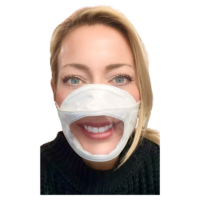
- The Canopy is a very interesting design. It is NOT NIOSH approved, though the company says it is working toward approval.
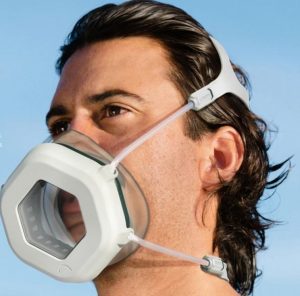
It now appears to meet N95 standards, but please note that it does not have NIOSH certification. It looks like it provides an excellent fit, as documented in this video below. (NOTE: The reviewer received a free sample.) It’s not clear to us how well this would work for teaching if you need to speak loudly.
The Canopy mask listed below is the ONLY clear reusable high-performance mask we are aware of at this time available in the USA.
Other clear masks on the market are likely no better than a cloth mask. However, there is one exception — the Savewo Smile, which appears to be made out of high filtration materials to the Korean KF94 mask standard. However, it is not clear how well it fits. There is at least one report from a mask expert that it has considerable leakage around the nose. It only appears available from foreign suppliers, such as here.
- Ford Motor Company announced Feb. 2, 2021 that it “has received patent-pending approval for an innovative new clear respirator it expects to certify to N95 standards of virus elimination.” The company says “Testing on the respirators to prove their effectiveness continues this winter, with expected availability sometime this spring.:
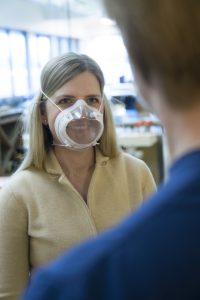
6.15 Strapless N95 Mask
Avery Dennison Medical and Global Safety First have a unique strapless mask, which is the only NIOSH approved strapless N95 respirator on the market. This unique design boasts excellent fit and breathability. There is an excellent information page on the mask here at Avery Dennison Medicaland at ReadiMask. We found three online suppliers that appear to sell direct to the general public at Project N95, ReadiMask and Progress Medical.
The mask stays on your face through use of a special self-adhesive material. The mask is said to transmit sound well, and is one of the most comfortable N95s on the market.
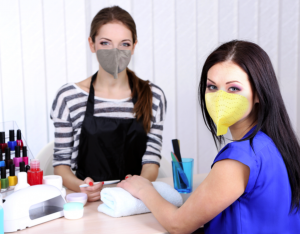
6.16 Kids Masks
The most protective mask (on paper) for your child won’t do much good if your child won’t keep it on or can’t get a good fit. So you may have to try some different masks to get one that works well for your child.
If you are looking for mask advice for kids 12 and under, this 20-minute video by Aaron Collins is an excellent introduction.
Collins also compiles a spreadsheet on masks for kids, which you can access here.
If you are looking for perhaps the most protective kid’s masks on the market, you should try the Flo Mask (designed especially for kids ages 4-12) or Castle Grade kid’s size mask, which is designed for kids ages 7-11 (there are adult sizes too that may fit older kids). Both are a reusable elastomeric mask with two-way filtration.
Castle provided us with laboratory test results that indicate its filters provide high filtration at over 95%. Its elastomeric construction and use of head straps, which we recommend, should provide a good fit. The company provided a video showing it passing a hospital-grade fit test on an adult.
The mask also comes in three sizes, one appropriate for kids and two for adults. The cost is $30 complete with an initial set of five filters, which are rated for 32 hours or one week. Filters cost as little as $1.50 each in packs of 50. The company says it has applied for NIOSH certification on adults.
Professor Jose-Luis Jimenez of the University of Colorado, Boulder, who is one of the top experts on aerosol transmission of the virus, bought one of these for his seven-year old son. He tweeted that it “fits definitely better than KN94 (sic) or other options we tried.”
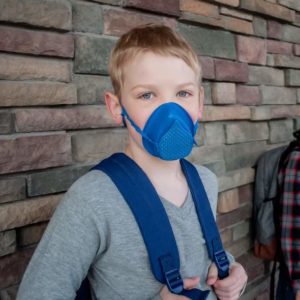
The Flo Mask is designed especially for kids. The company says the mask is “designed for little lungs, so we focused heavily on the breathability of our filter.” It has fewer layers and the company claims the filter has “unparalleled breathability.” This reusable mask offers a silicone seal and a filter tested by Nelson Labs that for the samples offered over 99% filtration efficiency and good breathability. It was one of 10 Phase 1 winners in the Biomedical Advanced Research and Development Authority “Mask Innovation Challenge: Building Tomorrow’s Mask.” It costs $50 with five filters. Packs of 25 filters cost $25, with the filters are “rated for 8 hours of continuous use under normal air quality conditions.”
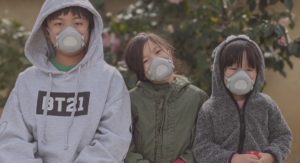
6.17 Masks for a Magnetic Resonance Imaging (MRI) exam
The FDA advises “that patients may be injured if they wear face masks (such as surgical or non-surgical masks and respirators) with metal parts and coatings during a Magnetic Resonance Imaging (MRI) exam. Metal parts, like nose pieces sometimes called nose clips or wires, nanoparticles (ultrafine particles), or antimicrobial coating that may contain metal (such as silver or copper), may become hot and burn the patient during an MRI. The FDA recommends patients wear face masks with no metal during MRIs.”
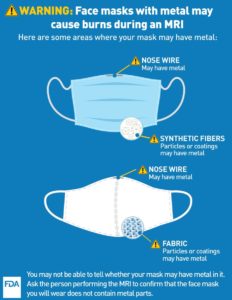
The manufacturers of the following masks have confirmed to us that the following masks have no metal parts. As we learn of more, we’ll add them here.
- Moldex N95s with either the HandyStrap or SmartStrap.
- The ReadiMask Strapless N95.
- The Airgami.
Here is a tweet with a letter from the maker of the ReadiMask attesting to its suitability for an MRI.
Happy to report my husband was able to use a N95 Readimask during his MRI. Had to talk to the supervisor to do it. Don’t buy the “surgical mask only” schtick. Readimasks stick to your face & have no metal. pic.twitter.com/SJfkMoWjZ1
— curiouser and curiouser (@SueSueCurious) January 13, 2022
7. Getting a Good Fit and Using a Respirator Mask
We strongly recommend you read this excellent document by 3M, which is titled “Filtering Facepiece Respirators FAQ: General Public.”
It covers the following topics:
1) Respirators vs. Masks and Face Coverings
2) Types of Respirators
3) How Respirators Work
4) Who Can Use Respirators?
5) How to Use Respirators
6) Comfort Considerations
7) Aesthetic Considerations
8) Other Questions
7.1 How to check to see if your mask is providing a good fit.
Remember that the best mask filtration material won’t do you much good if your mask doesn’t fit your face well. It will leak unfiltered air around your mask.
If you have an N95, be sure to watch the video below so you have better idea about how to use it. We recommend you print out this short guide on how to do a user seal check. This same advice should be followed for other medical grade masks, such as N99, N100, KF94, FFP2, FFP3 and KN95.
Look for masks that come in different sizes and consider different designs. A one-size-fits-all mask may well not fit you well. So consider a mask that comes in different sizes. You might get a better fit from a different size or even different type of mask. This may be especially true for N95 masks, which come in different shapes, with cone/cup, v-fold, duckbill being the most common. One of those shapes might work better on your face.
Keep in mind that a mask that has been NIOSH approved didn’t necessarily submit fit test data. And of those that do submit fit test data, not all submit data for each of NIOSH’s 10 face sizes. And of those that are submitted, up to four of 18 can fail and still obtain certification. Your face might be similar to the one where the certified mask either didn’t pass or barely passed.
If you have a hard-to-fit face, consider trying the SoftSeal brand masks, which have a silicone seal around the edges. It is one of the few masks that come in multiple sizes, including small. The Better Mask High Filtration System, a combination of a mask brace (available in small, medium, and large) and 30 high-quality surgical masks, is another good option.
A mask that fits a friend or even a sibling well might not fit your face well. This is documented in studies (such as here and here) and is most clearly explained here in a Fix The Mask blog post. One mask discussed in the post provided a similar (low quality) seal on two sisters but another mask provided 94% total filtration for one sister and just 73% for the other.
Many masks come with adjustable straps. If your mask has an adjustable strap, use it to obtain a tight fit. Many people who are getting a poor fit fail to adjust their ear or head straps.
Earloop masks. If you have an earloop mask and the straps do not adjust, your best bet is to buy or make an ear savers attachment, which not only take the pressure off your ears, but it will likely improve your fit. Alternatively, you may be able to cut the earloops in the middle and then tie them to use as headbands.
If your mask has a nose wire, be sure to adjust it to get a better seal around your nose. If you are getting fogging on your glasses, you need to improve the seal around your nose.
N95 fold style masks and KN95 masks. If you have a fold style N95 mask or KN95 mask, you need to work the nose wire to get a proper seal. It comes out of the package with a v-shape in the nose wire. Since no one has a sharp v-shaped nose, you will need to reshape the nose wire to get a better fit.

The video in this tweet is an excellent explanation of how to use fold style N95 mask or KN95 mask.
@Thatquaratined1 asked me to do a quick video about fixing the nose bridge fit on a KN95. Fold the wire flat and you can seal it around the your nose. pic.twitter.com/yDMHqkxZYp
— Amanda Hu (@amandalhu) December 20, 2021
Here’s a video on how to do a user seal check:
This tweet thread by Dr. Richard Corsi shows a quick way to check on how well your mask fits.
2/ Take first one out and place it directly in from of mask. As you breathe, the high water vapor content of your warm breath will condense on the lens, a good thing as it shows air going through mask. pic.twitter.com/5cuSfLxoA8
— Dr. Richard Corsi (@CorsIAQ) August 3, 2021
4/ Repeated with good seal and no visible condensation. This took about two minutes. Lack of visible condensation does not mean zero leakage, but does give a good indication of relative fit. Aim for zero visible condensation around edges and a lot adjacent to front of mask.
— Dr. Richard Corsi (@CorsIAQ) August 3, 2021
6/ This is not a perfect fit test, but it does make use of the high absolute humidity on breath and is a bit more scientific than other methods I’ve seen people reporting.
— Dr. Richard Corsi (@CorsIAQ) August 3, 2021
8.0 Reusing a Disposable Respirator Mask
If you are using a disposable respirator mask for personal, not medical use, it is safe to reuse it. The basic advice is to store it in a paper bag for a few days and reuse it. This article by The Wirecutter gives solid advice on reuse.
Note that you should NEVER wash and NEVER use any liquids (such as rubbing alcohol, hand sanitizer, bleach, or hydrogen peroxide) on your disposable respirator. You will damage the mask and possibly expose yourself to dangerous chemicals.
Disposable respirator masks are supposed to be disposed of after one use by medical professionals. But early in the pandemic, when N95 supplies were scarce, doctors and nurses found themselves reusing their respirators.
The CDC has a web page on decontamination & reuse of N95 respirators worth consulting if you plan to reuse your N95 or another disposable respirator.
The general guidance from manufacturers and the CDC is to not reuse a disposable respirator more than five times. Before reuse, you should ensure there is no visible damage to the filter or straps and that it is not soiled. If it does not fit well or it becomes hard to breathe, you should discard it. Do not share your mask with someone else.
Assuming you do not work in a healthcare setting, here are some of the key CDC recommendations:
“Hang used respirators in a designated storage area or keep them in a clean, breathable container such as a paper bag between uses. To minimize potential cross-contamination, store respirators so that they do not touch each other and the person using the respirator is clearly identified. Storage containers should be disposed of or cleaned regularly.
“Clean hands with soap and water or an alcohol-based hand sanitizer before and after touching or adjusting the respirator (if necessary for comfort or to maintain fit).
“Avoid touching the inside of the respirator. If inadvertent contact is made with the inside of the respirator, discard the respirator and perform hand hygiene as described above.
“Use a pair of clean (non-sterile) gloves when donning a used N95 respirator and performing a user seal check. Discard gloves after the N95 respirator is donned and any adjustments are made to ensure the respirator is sitting comfortably on your face with a good seal…..
Follow the manufacturer’s user instructions, including conducting a user seal check.
Follow the employer’s maximum number of donnings (or up to five if the manufacturer does not provide a recommendation) and recommended inspection procedures.
Discard any respirator that is obviously damaged or becomes hard to breathe through.
Pack or store respirators between uses so that they do not become damaged or deformed.
In a New York Times interview with Zeynep Tufekci, she gave the following advice:
Zeynep: I will give a modified version of what health care workers were advised during the worst of the shortages. Rotating a few is enough for disinfection. Just let them rest for a few days in a non-airtight container (like a paper bag or a Tupperware container with holes) and replace one only when it no longer fits well or the elastics have gone soft, or if it is soiled. It’s also good to use hand-sanitizer before putting them on and taking them off. Handle them gently, because a good fit is essential to getting the most out of it. My sense from having heard a lot from people using all the other disinfection methods, like heat, is that they just increase the risk of damaging the mask….
Zeynep: If I were wearing an N95 just for the weekly grocery store run, I’d probably be fine with alternating two carefully handled masks for many months as long as the elastic works and there’s no soiling. That’s not a lot of use! But if I were wearing one all day, every workday, I’d consider having one for each day and replacing them maybe every month. So that’s about five per month. Could one be really careful and make that two months? Probably.
9.1 Better Masks for Teaching
Teachers need strong protection, but they also need to be heard clearly. Here are options of special interest for teachers.
The 3M VFlex 9105 has pleats that “flex with mouth movement while talking,” and it is economical. It appears the minimum purchase size is 50 in a box, but this option may well be the most affordable mask that offers N95 protection while talking. It’s a duckbill style, so it does look a bit weird. To see it in action, Aaron Collins tested it here.
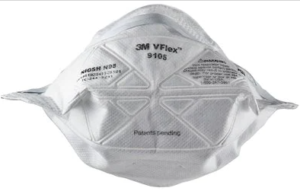
The Airgami, which is profiled above here, has several features that may make it especially suitable for teaching.
- The design is unique in that it allows unusual movement of the mouth when speaking compared to other respirators. This helps the wearer speak more naturally and with more confidence that their mask won’t slip off when speaking relatively loudly.
- The design appears to allow unusually easy breathability. Again, for persons speaking relatively loudly over an extended period of time, this design feature should be a strong plus.
- The design looks as if it would convey sound well. However, we have not purchased one and we have never seen one in use. At least one user, who is expert on masks and has bought many masks of all kinds, confirms it transmits sound very well, perhaps the best of any mask with its level of protection.

The Envo Mask is profiled above here. It’s NIOSH approved and is perhaps the most cost effective option over the long run. Like all elastomerics, you only change the filters, which last longer than N95 masks. It likely does not transmit your voice as well as the Airgami, but many people believe it transmits speaking better than any elastomeric mask. It only comes in one size, so it may not work well for your face. Elastomeric masks, like this one, are very comfortable to wear over extended times, far more so than any conventional N95 disposable respirator.

The mask brace plus surgical mask, explained above, is also a cost-effective option for many. It will transmit sound better than most N95s, but offers close to N95 protection. The Fix the Mask brace plus surgical is thought to protect better than many N95s when speaking because it is flexible. Of the mask fitters on the market, we believe the Fix the Mask brace is the best for teaching. You also have good flexibility to get more comfort when heading outdoors, where the risk of transmission is lower, by taking off the brace, but continuing to wear the surgical mask. The CDC recommends the use of mask fitters like the Fix the Mask brace.

The Canopy is likely the best better mask option on the market for those who teach deaf students, teachers using American Sign Language, or persons who need to convey facial expressions. It is not NIOSH approved, though the company says it is working toward approval. Other clear masks on the market, other than the Savewo Smile (available only from foreign suppliers), that we are aware of offer much worse fit and filtration. See our explanation above for more info.

9.2 Masks for retail sales employees and wait staff at restaurants
In addition to high grade protection, we assume that priorities for wait staff include breathability, comfort, ability to talk while maintaining good fit, and style.
The Airgami, which is profiled above here, has several features that may make it especially suitable for wait staff. It does have a higher price, but the manufacturer says it can be reused until “the filter gets clogged with dust and becomes hard to breathe through, or if the insides get dirty and contaminated, or if the respirator is punctured, crushed, or otherwise structurally damaged.”.
- No other mask beats the mask for style. If employee appearance is important to a store or restaurant manager, the Airgami is clearly the top choice. It comes in 16 different colors, and one is shown below.
- The design is unique in that it allows unusual movement of the mouth when speaking compared to other respirators. This helps the wearer speak more naturally and with more confidence that their mask won’t slip off when speaking relatively loudly.
- The design appears to allow unusually easy breathability. Again, for persons speaking relatively loudly over an extended period of time, this design feature should be a strong plus.
- Those who have tried it say it conveys sound well. However, we have not purchased one and we have never seen one in use. At least one user, who is expert on masks and has bought many masks of all kinds, confirms it transmits sound very well, perhaps the best of any mask with its level of protection.

If you don’t care about style, the 3M VFlex 9105 has pleats that “flex with mouth movement while talking,” and it is economical. It appears the minimum purchase size is 50 in a box, but this option may well be the most affordable mask that offers N95 protection while talking. It’s a duckbill style, so it does look a bit weird. To see it in action, Aaron Collins tested it here.

The mask brace plus surgical mask, explained above, is also a cost-effective option for many. It will transmit sound better than most N95s, but offers close to N95 protection. The Fix the Mask brace plus surgical is thought to protect better than many N95s when speaking because it is flexible. Of the mask fitters on the market, we believe the Fix the Mask brace is the best for wait staff. The CDC recommends the use of mask fitters like the Fix the Mask brace.

9.3 Clear Masks — Communicating with deaf persons, use by persons using American Sign Language, or persons who need to convey facial expressions
The Optel P.Air Clear N95 is the only NIOSH-certified clear mask that we are aware of. It is surprisingly affordable at a list price of about $40 for a pack of 20 masks.

The Canopy is likely the best (and perhaps only) reusable better mask option on the market for those who teach deaf students, teachers using American Sign Language, or persons who need to convey facial expressions. It is not NIOSH approved, though the company says it is working toward approval.

The Savewo Smile, which appears to be made out of high filtration materials to the Korean KF94 mask standard, is a step down in protection from the Canopy, but by far the next best option available. However, it is not clear how well it fits. There is at least one report from a mask expert that it has considerable leakage around the nose. It only appears available from foreign suppliers, such as here..
Other clear masks on the market that we are aware of offer much worse fit and filtration. See our explanation above for more info.
9.4 Hair Salons
The Strapless N95 Face Mask is by far the best option for hair stylists and their customers. This is a NIOSH approved N95 respirator with terrrific fit and breathability. For hair cutting and styling, its huge advantage is the strapless design.The only concern is that many customers won’t know how to put one on. See our explanation above for more info.
